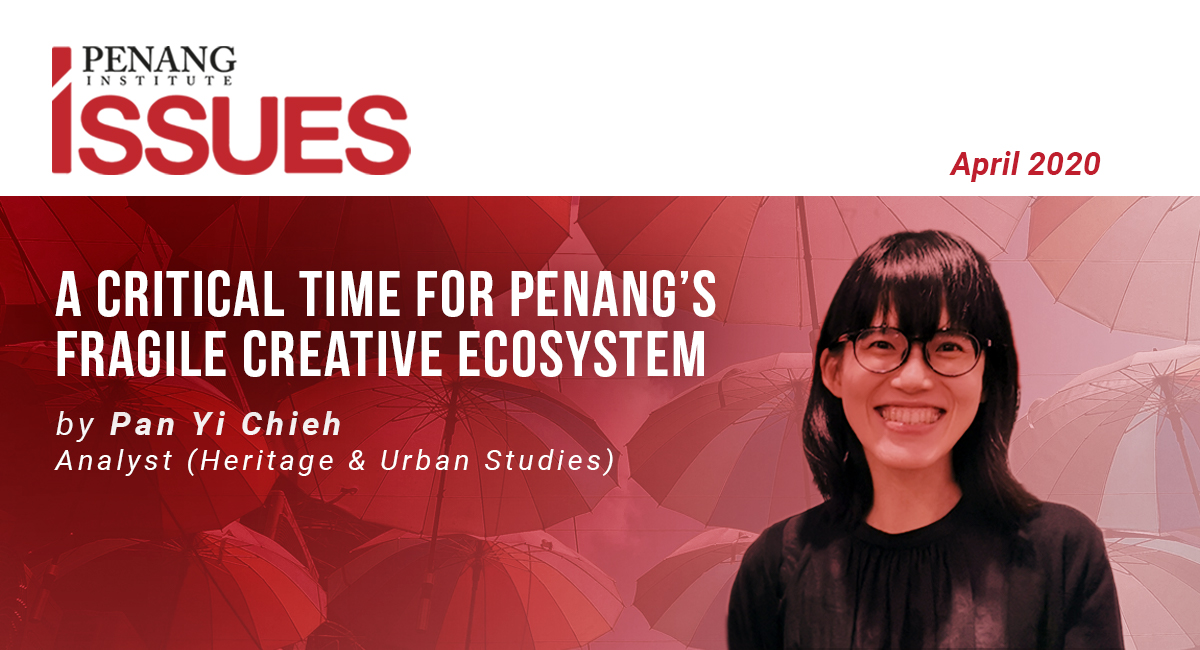Executive Summary
- The Covid-19 outbreak and the social distancing that followed have brought broad economic downturns across the world. Among the worst hit has been the Arts and Culture Sector
- Some countries have implemented relief programmes to provide immediate support to artists and cultural establishments, as well as to build capacity for the longer term. Digital technologies have been of great help in that context, but they also pose challenges for certain art and cultural forms
- Over the past dozen years following George Town’s gaining of UNESCO World Heritage Status, its creative ecosystem has been undergoing steady changes, and has helped turn the city more than ever into an internationally famous tourist destination, in certain areas enriching the local cultural scene in the process
- However, serious worries have emerged about Penang’s creative ecosystem today, such as the ever stronger dependence of the arts on state-organised festivals as the main funding channels, and the lack of policy tools to cater to the different creative dynamics in the state
- The Covid-19 crisis provides a much-needed and precious moment to contemplate the nature of this development, and to relocate local dynamics as the key element in the further development of the creative ecosystem
INTRODUCTION
The Covid-19 outbreak and the social distancing measures adopted throughout the world to limit the spread of the disease very quickly disrupted both the supply and demand for goods and services. This in turn, made it necessary for governments at all levels to put into place relief programmes to help individuals and businesses survive this unprecedented crisis.
Among the sectors hit much more than others is the Arts and Culture Sector. Cultural and art institutions around the world have had to stay closed, and immediately threatened the jobs and livelihood of art and cultural workers, even in the most established art institutions.[1]
Malaysia’s situation is no different. In Penang, often considered the country’s Culture City, the Arts and Culture Sector faces grave challenges, but also opportunities for the future.
GOING DIGITAL AND CREATIVE
Where the Arts and Culture Sector is concerned, the relief programmes throughout the world have essentially been aimed at sustaining individuals. The disbursement of funds has generally followed two directions. First, they seek to compensate for loss of salaries or for the operational losses that they have had to endure despite the absence of any income being generated, such as rentals. Most generously, the German government granted € 5000 for each individual affected.[2]
The second type of relief funds are those aimed at capacity building. These encourage the exploration of new possibilities such as upskill, digital transformation, training etc, for the individuals involved. For example, in Taiwan, where the creative sector is small and fragmented, much funding has been of this type. It is also hoped that whatever develops in the coming months can be sustained into the future.[3]
This moment also reminds us of the importance of the community in the development of the arts. Online discussions worldwide in support of the art community have been plentiful, and many are with regard to the exploring of new art forms.
Traditionally, the Arts and Culture Sector grows through close interaction between the audience and the art. These experiences are very much embodied in spaces. Therefore, concrete infrastructures such as galleries, museums, theatres and concert halls have importantly shaped people’s absorption and enjoyment of art. With a trend towards decentralisation, diverse platforms have in recent times merged to allow for more innovative artistic expressions, be it through alternative space and online platforms. Also, technology has become more commonly adopted at shows, not only as a backdrop but even for interaction between audience and performers or artists. Museums and galleries have also found it useful to put their collections and exhibitions online for viewing, offering new aspects to the experience.
These online resources, attracting a wider audience, remove barriers for the enjoyment and consumption of art, not least for people living far away who cannot travel or cannot afford the cost of travel to the gallery or museum.
With social distancing measures being suddenly implemented throughout the world, this adoption of digitization in the presentation of art collections and museums and galleries especially those in metropolitan centres, has turned out to be very useful. It has allowed for people worldwide to access and enjoy these online resources from the isolation of their home.[4]
Similarly, digitization offers the most promise as a strategy for the art establishments and individuals to get through this crisis. In any case, it is prone to speed up the transformation of the field. For example, the crisis has caused bookstores to stay close. Investing on online presence, however, makes it more probable for small and independent bookstores to survive.[5] However, digitization is not a panacea for every challenge we are presently encountering. While it offers new opportunities, it also entails the learning and adopting of very different and complicated norms, such as those regarding relations with the audience, between art forms and among stakeholders within the ecosystem.
For the visual art scene, challenges include how the audience is to be attracted to the artworks through digital tools, and of course, how and in what form they can purchase them. This involves different factors such as promoting skills, the nature of the artworks, the creators themselves, etc.
For the performing arts, some challenges call for sophisticated means to handle. To be effective and rewarding, the online platform has to stimulate a variety of appropriate emotions from the online audience for the performance.[6] This to some extent requires different methods of staging and for equipment to suit that.
Therefore, going digital is not simply about putting contents online. There are many aspects to explore, and these concerns the ecosystem’s internal dynamics as a whole, as well as reliable knowledge about the nature of current establishments, the current socioeconomic conditions of artists and artistes, and the role of the state and its conception of the Arts and Culture Sector within the local economy.
CHALLENGES FACINGTHE GEORGE TOWN ART SCENE[7]
For the dozen years or so, Penang had been witnessing a transformation of its creative ecosystem. Most notably, this followed the listing of George Town as a UNESCO World Heritage Site in 2008.[8] The impact of that event has been obvious and wide-ranging. The attention paid to Penang by the world’s travel industry has heightened the tourism status of the state, and even altered the self-imagining of its inhabitants. This has naturally led to deep disagreements about how Penang is to develop when taking advantage of this new-found fame.
For one thing, George Town has become a magnet attracting well-known talents from different corners of the world to base themselves there. These have helped establish new fields in the arts, and contributed to a vibrant and wider ecosystem. This evolving ecosystem now includes, but is not limited to, bookshops, publishers, writers, artists, curators, musicians, art societies, performing art groups, photographers, designers, art and cultural workers, innovative art and cultural spaces, and many other supporting individuals. This has had a deep impact on tourism in general, and also enriched and altered much of the street life in the heritage area and beyond.
Bookstores provide thinking spaces for the weary pedestrian, while cafes function as venues for discussions and exhibitions for all manners of artists. There are now city magazines, such as the 10-year-old Penang Monthly and the 5-year-old Penang City Eye, to tell valuable stories about Penang that would otherwise be forgotten; and cultural workers accompanying children to explore the city as part of their arts education have become a common sight. And cycling has become a fad across the island.
The list goes on, and together, all these new phenomena have added to the allure of George Town.
However, in general, a large percentage of workers in this field are self-employed and freelancers who survive by taking on different projects that happen to come their way. Many of Penang’s micro and small establishments such as cafes, bookshops and publishers live on limited resources. These are key components in Penang’s creative ecosystem. They are closely interconnected and through mutual support and the sharing of resources are able to keep afloat. This spirit characterises the George Town art scene. While valuable and essential, such an ecosystem faces strong challenges in the long term. And as with the arts in general, support and funding from the state and from sponsors, along with local purchaser support are key to their survival.
Among the many challenges today is the overdependence on the locally organised large festivals as the main funding channels. For the past ten years, George Town festivals have not only become important national and regional events, they have also become the major platforms for artists to participate in and to gain experiences and support from. For some of them, the subsidies for exhibitions and performances mean a lot to their career development. Therefore, the cancellation of festivals this year will see a huge impact, not only on the artists, but on the ecosystem as a whole.
New creative areas have appeared in recent years in response to the heightened international status of George Town as Malaysia’s Culture City. We see this in the setup of online platforms, diverse collaborations among the various fields, and the emergence of visual artists who are now more willing to get into experimentations, etc. This vibrant dynamics that have meant so much to George Town, and will mean a lot to its immediate future as a cultural hub, is under serious threat.
At this difficult time, therefore, various forms of support for individuals and institutions are needed. Penang Art District, for example, has begun collecting information and feedback from these instances and to hold discussions with them. Hopefully, this will lead to concrete steps from the state to fund and support this vital Sector on which Penang’s self-image depends upon, as much as it does on the Manufacturing Sector.[9]
SMALL, AND THEREFORE SUSTAINABLE?
Penang’s creative ecosystem, being small-scale, makes it vibrant and flexible. But it leaves it fragile as well. Therefore, without knowing how long the Covid-19 crisis will continue, and how far into the future the slowed level of economic activity—and travel—will go, Penang society and its government will need to be very proactive in planning for the future of its creative ecosystem.
Naturally, the short-term policy has to be focused on immediate support for individuals, groups and small businesses in the sector. The sector being a very diverse one, and by nature rather unregulated and unorganised, ascertaining where funds should be channelled and to whom is already a huge problem.
In the medium term, better policy tools will need to be created. At this urgent stage, some quick criteria nevertheless, need to be established so that the truly needy are not overlooked. For example, in terms of the cancellation of the George Town Festival, thorough evaluation needs to be conducted into the conditions of the individuals and groups who are badly affected. Some subsidies can be channelled to those who endure production losses, the loss of income from ticket sales, and investments already made to prepare for the event, etc. Clearly, no big event to push performance venues that are now hit by the social distancing measures, is on the horizon.
But in the longer term, it is the survival of these establishments that will allow for a quick revival of the ecosystem as a whole. For long-term goals therefore, it is essential to focus on a policy scheme that cares for the existing diversity in the creative sector.
State policy vis-à-vis the Arts and Culture Sector over the last ten years has been anchored on formulating notions of heritage, which to a large extent has placed attention on fields such as architecture, heritage expertise, craftsmen, heritage object owners and others. Where policy tools for this sector are concerned, the idea had been to rely on state-based institutions and agencies such as Penang State Art Gallery (PSAG), George Town World Heritage Incorporated, and Penang Art District (PAD).
However, and more clearly over time, this approach falls short of capturing and supporting the diverse nature of the stimuli that Penang has been experiencing; and these go beyond tourism or heritage preservation to include connectivity issues, political ambitions and techno-economic challenges, which all affect the creative tendencies of Penang’s diverse and cosmopolitan population. From below, over the last ten years as well, more and more collectives have been established by individuals in response to their new reality.
This is all part and parcel of the vitality and creativity in George Town. While huge festivals such as George Town Festival and George Town Literary Festival have played roles in developing the reputation of the state, more sustainable mechanisms that have clear trickle-down effects are sorely needed. For example, more supporting systems that stimulate consciousness about heritage and Penang’s literature and its performing arts would enhance interactions across fields that are not easily identified, and encourage creative elements to deepen society’s self-image and confidence, and energise its productive powers.
A properly functioning funding mechanism that is aimed at the maintenance and development of Penang’s creative ecosystem instead of singular items would heighten the role of local culture in defining the future economic, cultural and political path of the state. For example, holding exhibitions may be an important element in state support of the visual arts, and these allow for the public to access and appreciate arts. However, artists cannot live on that alone. The exhibiting of their artworks has to lead to purchases by private or corporate collectors. Involving society as a whole into policies concerning the creative sector is therefore a necessary path to take in allowing that sector to be vibrant, sustainable, and to produce surprising and unexpected art items and events.
The state’s institutions connected to this sector should function in a more open fashion, more as stimulants for, rather than as managers of the art scene.
The challenges faced by actors within the creative sector are still not fully understood, and definitely not highlighted in policy circles. For example, while the performing art scene has become vibrant in recent years, most groups still face basic challenges such as the burdensome costs of renting a rehearsal venue.[10] Being an old city, George Town does have vacant spaces. These may be owned by different arms of the state, or managed by complicated legal structures; but negotiations and other means should be adopted to free these places up so that they can be properly used for the socio-cultural wellbeing of society in general, and for the good even of owners who presently are unable to imagine profitable use of these places.
This could be an effective way for supporting the local ecosystem while reviving old buildings and urban areas. Such methods have been proven successful in many cites through the world, and they have acted most effectively as assets for the education of the young, and raising historical consciousness in the local population.
Lastly, talent cultivation is essential to the establishment and sustaining of the creative ecosystem; every segment in the ecosystem needs to learn and upskill to adapt to future challenges. Therefore, a mechanism for capacity building is important, which can fund the exploration of different and revolutionary content and forms, and which provide possibilities for the embracing of old and new skills and knowledge.
It is necessary that policies be put in place to save the Arts and Culture Sector that is so vital to he identity and economy of Penang, but the Covid-19 crisis makes it obvious that in doing that, we have to aim beyond merely supporting what we have, and instead embrace the new situation that digitalisation brings and accepting the new limits that pandemics such this place on how we create and consume art and culture.
[1] MoMA Terminates All Museum Educator Contracts: https://hyperallergic.com/551571/moma-educator-contracts/
[2] https://news.artnet.com/art-world/german-bailout-50-billion-1815396?fbclid=IwAR34ZSVf8Mcls0Xag2-tNZu4PgTrlHbSPu 6CA-PqrYBe5R0n6WIlhvD6HNs
[3] On the relief programme of the Taiwan’s Ministry of Culture, see https://www.moc.gov.tw/content_434.html
[4] https://www.dw.com/en/six-museums-to-explore-virtually-during-lockdown/a-53073411
[5] http://www.bbc.com/culture/story/20200323-covid-19-how-bookshops-around-the-world-are-responding
[6] During this period, Segal Talks invited theatre artists to discuss their current working conditions and to share their knowledge about new practices around the world. Howlround, a free and open platform for theatre makers worldwide, also discussed various theatre practices (https://howlround.com/)
[7] See Alexander Fernandez, Lim Sok Swan and Pan Yi Chieh, The Creative Industries as Cultural and Economic Catalyst, February 2020, Penang Monthly.
[8] Building the creative technology ecosystem: https://www.buletinmutiara.com/building-the-creative-technology-ecosystem/; Penang a hub for art scene https://www.buletinmutiara.com/penang-a-hub-for-art-scene/
[9] Under the Movement Control Order, Penang Art District conducted several rounds of discussions with members of the art community to gather feedback about their situation.
[10] Petition from Penang Arts & Culture Organisations and Freelancers. 8th April 2020.
Managing Editor: Ooi Kee Beng, Editorial Team: Alexander Fernandez and Nur Fitriah (designer)
You might also like:
![Policymaking and Implementation: Shifting from Hierarchies to Interdependent Polycentric Networks]()
Policymaking and Implementation: Shifting from Hierarchies to Interdependent Polycentric Networks
![Decentralisation is the Best Pro-Growth and Pro-Poor Economic Strategy for New Malaysia]()
Decentralisation is the Best Pro-Growth and Pro-Poor Economic Strategy for New Malaysia
![How Tools from the Discipline of History Can Improve Public Policymaking]()
How Tools from the Discipline of History Can Improve Public Policymaking
![Need for Speed: Survey Findings on Penang Internet Connectivity]()
Need for Speed: Survey Findings on Penang Internet Connectivity
![EU-Malaysia Trade Ties Strengthen despite Persistent Differences]()
EU-Malaysia Trade Ties Strengthen despite Persistent Differences







